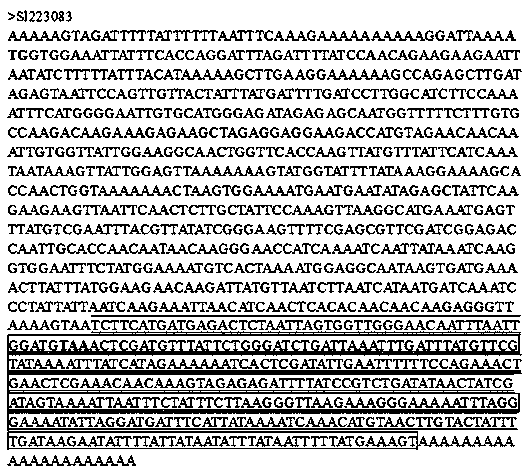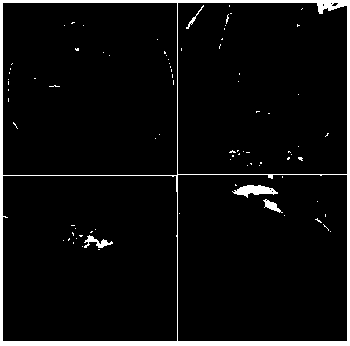Tomato fruit maturing gene S10658 and application thereof
A fruit and ripening technology, applied in the fields of molecular biology and genetic engineering, can solve the problem of slow fruit ripening process of transgenic tomato, achieve broad market application prospects, stable effect, and shorten the breeding cycle.
- Summary
- Abstract
- Description
- Claims
- Application Information
AI Technical Summary
Problems solved by technology
Method used
Image
Examples
Embodiment 1
[0023] Example 1: Sl0658 Cloning of 3'-specific fragments
[0024] Grind the fruit of tomato Ailsa Craig red maturity into powder with liquid nitrogen, transfer it to a centrifuge tube, and extract total RNA by Trizol method. Reverse transcriptase M-MLV (Tiangen) was used to synthesize the first strand of cDNA using total RNA as a template. The reaction system and operation process were as follows: take 5 μg total RNA, add 50 ng oligo(dT) 15, 2 μL dNTP (2.5 mM each), add ddH at the end 2O (no RNase) to a reaction volume of 13.5 μL; after mixing, heat denatured at 70°C for 5 minutes, then quickly cool on ice for 5 minutes, then add 4 μL 5×First-stand buffer, 0.5 μL RNase inhibitor in sequence (200 U), 1 μL reverse transcriptase (200 U), 1 μL dimercaptothreitol (0.1 M), mix well and centrifuge briefly, incubate at 42°C for 1.5 h, take it out and heat at 95°C for 5 min to terminate the reaction ; After the first strand of cDNA was synthesized, it was stored at -20°C for later...
Embodiment 2
[0027] Example 2: Plant Interference Expression Vector Construction
[0028] Sl0658 After the PCR product of the specific fragment at the 3' end was recovered, it was dissolved in TE buffer for BP reaction. The reaction system includes 50-100 ng of PCR product, 2 μL of 1300-35S-X vector, 4 μL of 5×BP cloning enzyme reaction buffer, 4 μL of BP cloning enzyme mixture, and supplemented TE buffer (PH8.0) to 20 μL . The reaction system was incubated at 25°C for 16 h, then 2 μL of proteinase K solution was added, and incubated at 37°C for 10 min to terminate the BP reaction. In order to obtain fragments carrying the inverted repeat target gene (such as figure 2 shown); positive clones were screened.
[0029] The constructed plant expression vector was transferred into the prepared Agrobacterium C58 competent cells by liquid nitrogen freeze-thaw method; the operation steps were as follows: take 2 μg of the expression vector plasmid and add it to a centrifuge tube containing 200...
Embodiment 3
[0030] Example 3: Genetic transformation of tomato
[0031] The genetic transformation system adopted is the genetic transformation method mediated by Agrobacterium, the Agrobacterium strain is C58, and the transformation recipient material is the wild tomato species Ailsa Craig. Soak plump tomato seeds in sodium hypochlorite solution (available chlorine content: 2%) for 15 min, then wash the seeds with distilled water and sow them on 1 / 2 MS medium at 25°C with a photoperiod of 16 h light / 8 h dark The cotyledons were cut out when the sterile seedlings grew to 7-9 days, and cultured on 1 / 2 MS medium in dark for one day. Agrobacteria with a resuspended concentration of OD600≈0.5 were used to infect the leaves for 5 min, and the excess bacterial liquid was blotted dry with sterilized filter paper, and then re-placed on the pre-medium covered with filter paper, cultured in the dark for 2 days, and then transferred to the screening medium ( Basal medium MS+zeatin 2.0 mg / L+kanamyci...
PUM
 Login to View More
Login to View More Abstract
Description
Claims
Application Information
 Login to View More
Login to View More - R&D
- Intellectual Property
- Life Sciences
- Materials
- Tech Scout
- Unparalleled Data Quality
- Higher Quality Content
- 60% Fewer Hallucinations
Browse by: Latest US Patents, China's latest patents, Technical Efficacy Thesaurus, Application Domain, Technology Topic, Popular Technical Reports.
© 2025 PatSnap. All rights reserved.Legal|Privacy policy|Modern Slavery Act Transparency Statement|Sitemap|About US| Contact US: help@patsnap.com



